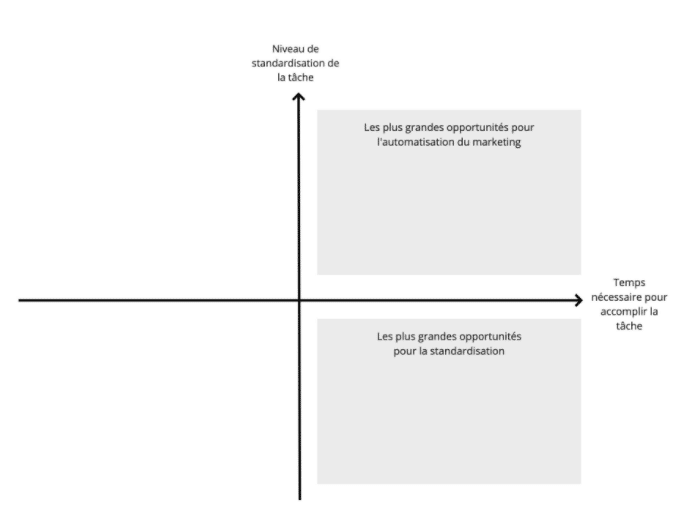Practice Leader, Relationship Marketing, Customer Experience
Marketing automation in a labour shortage
Practice Leader, Relationship Marketing, Customer Experience
The back-to-school season seems like it will be a new period of challenges for many Canadian companies. On the one hand, many uncertainties persist regarding the health crisis and its effects on operations. On the other hand, we’re in the midst of experiencing profound changes when it comes to values and behaviours in the digital space, which tends to promote inertia and the sense of a loss of direction. To this already-complex situation are added major technological changes that make data use a must, plus a labour shortage in the field of digital expertise, one that is particularly glaring in Canada.
Accelerating the digital growth of your business in this context is therefore a real headache for marketing leaders. In this article, I will discuss some possible solutions that can help you meet this toughest challenge, both human and technological. To do this, I offer you an approach borrowed from technology product managers that encourages reflection and testing, with the goal of growing your business sustainably.
If your team is already properly structured and you are ready to start marketing automation, we have already written several articles that you may find useful :
THE PANDEMIC IS RIPE FOR MARKETING AUTOMATION
The COVID-19 pandemic has brought about many changes in our society and across our organizations. Digital behaviors have grown at lightning speed and the adoption of new technologies has accelerated in all spheres of our lives, reinforcing the importance of a human-centered digital strategy .
In its latest analysis of the digital maturity of companies, Forrester points out that the most advanced companies have the main points in common: using cloud data as much as possible, working with integrated partners, involving customers early in their decision-making processes, in addition to applying design thinking and agile methodologies. All of these essential aspects of growth are the foundation of marketing automation.
-png.png)
Of course, not all Canadian companies are of the stature of Apple, Google, Facebook, Amazon, Microsoft or Netflix, and of course not all want to be. The digital maturity of these companies, particularly observable through the use they make of their primary data (first party data) to offer a quality experience to their users, is nevertheless a good model to follow for implementing a effective automation strategy.
In fact, the recent Harvey Nash/KPMG survey of technology executives ( the findings of which were published in this La Presse article ) shows that digital leaders generally invest 25 to 50% more in technologies than their competitors, are twice as good as others at winning customers' trust; three times better at creating a positive customer and employee experience; three times better at increasing their stock prices; three and a half times better at increasing their income and profits; and four times better at improving their operational efficiency.
However, it is difficult for a small or medium-sized business to initiate such digital transformation projects when its human resources and budget are limited. This is why it is essential to plan the marketing automation strategy by identifying the best candidates for a proof of concept.
Before we continue, let's keep in mind these few principles about marketing automation:
- Automation is an investment. More time is spent setting up automation than performing a single task in a workflow that is already working. Making time for planning and prioritizing scalable automations rather than aiming for ideal workflows from the start is a must. To start designing your strategy in a context of limited resources, you could for example pause the 10% of stocks that are the least profitable to invest this time in developing your automation strategy.
- Marketing automation requires knowledge of its primary data (first party) and the users for whom it is built , whether these users are customers or members of your teams. As part of automation built for the customer lifecycle, a company should employ channel reporting tools to understand the user journey (ideally omnichannel) as well as strategic planning tools such as definition of personas and mapping of the user journey. This will then facilitate decision making.
- Marketing automation requires technological tools (such as marketing or customer engagement automation platforms) and a certain comfort in using them effectively. Most platforms offer training and/or very rich documentation to support you in answering your questions related to their implementation and use.
ANALYZE THE CUSTOMER ACQUISITION AND CONVERSION JOURNEY USING FIRST-PARTY DATA
Whether you have already started automating your communications or want to begin the transition soon, it is important that you first determine if you have the possibility of measuring your high-level results (generated revenue, conversion), otherwise the definition of your business case may end there.
A good place to start might be to check that your conversion goals are set up in Google Analytics if your transactions are exclusively online, or in your CRM if they come from various sources. From there, you'll be able to get a view of the channels you're mobilizing and the campaigns you're running, as well as a view of their impact on revenue.
If you use several attribution models, I advise you to base your analyzes on the last point of contact when you carry out the exercise, for simplicity.
First define an ideal period to analyze your industry (for example, the last 365 days if your activity is subject to strong seasonality, or the last 3 to 6 months if it is not) and keep this same period in the following analyses. Then, note your conversion rates by channel and compare the results to industry statistics to get a better idea of optimization potential. Finally, write down your revenue as well as the share of revenue generated by channel and (ideally) by campaign. This will then allow you to establish an order of priority useful for the effective implementation of your future marketing efforts.


DEFINE OPERATIONAL IRRITANTS AND DETERMINE THEIR LEVEL OF STANDARDIZATION
Now that you have a good idea of your optimization potential, you can carry out a targeted analysis for each channel mobilized, with the objective of determining the amount of effort your organization has invested in their implementation on a monthly basis. . To do this, identify the main tasks related to the use of this channel and assign them a value in terms of their level of standardization.
Example :
- Highly standardized: a documented procedure must be followed to perform the task;
- Not very standardized: the task is always carried out via a tailor-made procedure that is difficult to standardize.
If you have already identified actions that you want to carry out in the near future, add them to your list while emphasizing their more estimated nature.
Once this is done, you will be able to identify your operational pain points more clearly. In order to establish an order of priority as to their resolution, you can classify them in a Cartesian plan showing the level of standardization of the task and the time required to complete the task . This will help you quickly identify the most profitable opportunities for marketing automation.

IDENTIFY PROBLEMS THAT CAN EASILY BE SOLVED BY AUTOMATION
Not all of the tasks that you do with a high level of standardization will necessarily be able to be automated with marketing automation software. This is particularly the case for certain business processes such as project management (however, to remedy such a problem, you could equip yourself with agile project management software such as Jira, for example, which offers advanced automation solutions).
The tasks most likely to be simplified and improved by marketing automation are those related to core solution functionality. In other words, these are the tasks related to contact management, message management, and message reporting .
Then, define your objectives for these tasks by identifying if it is a question of saving time in operationalization (ideal for refocusing activities on tasks that create more value in a context of labor shortage) or rather to generate income.
BRAINSTORM TO IDENTIFY MARKETING AUTOMATION SOLUTIONS
Ideally as a team, brainstorm simple marketing automation solutions. To do this, identify your priority tasks for automation and organize them into a sequence :
- The action to be carried out
- Example 1: Send an email presenting our service offers
- Example 2: Add a contact to a Facebook campaign
- When it should be done
- Example 1: 5 days after subscribers sign up for the newsletter
- Example 2: 3 months after the first purchase
- Why it needs to be automated (its goal)
- Example 1: To generate sales opportunities immediately
- Example 2: To eliminate the time spent managing import lists in Facebook (1 hour per week) and improve the acquisition cost
- Where and how it will be automated (if you already know a way to perform the automation):
- Example 1: In Hubspot using a workflow, a segmented list and an automated email
- Example 2: In Klaviyo, using a Shopify connector to retrieve purchase information, and a Facebook connector to push the audience created in Klaviyo (customer segment).
TARGET A MARKETING AUTOMATION FOR PROOF OF CONCEPT AND TAKE ACTION
When the brainstorming is complete, you will have in hand a list of marketing automation solutions with a strong potential impact on generating revenue and saving time.
If you have been able to identify the technical solutions to be mobilized, you can now invest your efforts in the simplest ones to implement. If, on the contrary, the technical aspect remains vague at this stage, you will have to do a little research within the documentation provided by the platforms you use, or even call on technical advisers (IT service or consultants) .

Then implement the best candidate solution. Be sure to keep a written record of the time and investment needed to implement it: this will be very useful when the time comes to draw up your balance sheet.
Another tip for this step: favor the simplest possible execution by always prioritizing efficiency before quality. For example, if you're creating an email automation, don't invest too much time in designing the email. This aspect can be refined later, during your optimization phases.
LAUNCH MARKETING AUTOMATION PILOT
When the pilot project is launched, it is important to monitor the proper functioning of the automation and to modify it if performance problems arise.
When creating a sequence of emails, for example, you might find that a message was sent to fewer or more people than expected. Further investigation could then reveal, among other things, that the chosen segmentation excludes certain people from the mailing list.
Regardless of the nature of the problem identified, it is then necessary to identify the causes and quickly implement optimizations to respond adequately.
TAKE STOCK OF THE MARKETING AUTOMATION PILOT PROJECT AND BUILD A BUSINESS CASE FOR SPECIALIZED RESOURCES
When no performance problem is identified, we can then carry out the cost/gain balance sheet on the objectives, and thus assess the true value brought by this automation.
Doing so, one could conclude, for example, that automating a sequence of emails required 16 hours of work and generated $2,000 in additional revenue, in addition to allowing the company to save 8 hours of productivity course of the next few months.
Thanks to your pilot project and the work of identifying opportunities and solutions carried out from the outset, you will be able to build a solid business case, drawing up a detailed portrait of your situation, where your problems would be listed and the solutions to be used to remedy this. This exercise will even allow you to estimate the cost and benefits of your projects by reproducing the approach presented in this article.
Whether you need additional resources or a new roadmap for your initiatives, then you'll see more clearly how marketing automation can accelerate your digital growth when used intelligently.




